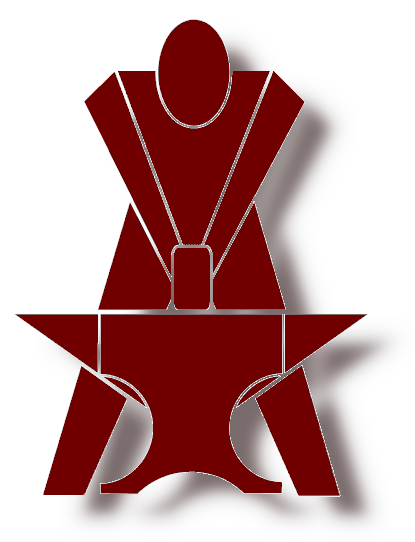



Tips on Suspension Service |
||||||||||||||||||||||||||||||
|
Forward
This booklet is intended to be used as a guide to proper maintenance of leaf spring suspension systems and must not be considered a repair manual. Since the leaf spring suspension systems vary greatly between manufacturers of the many vehicles on the road today, we strongly recommend that the mechanic be thoroughly familiar with the particular vehicle he is servicing. Failure to provide proper leaf spring suspension maintenance may result in serious damage to the vehicle and serious injury or death to the operator and others associated with the operation of the vehicle. We, at Triangle Auto Spring, Flagg Steel Products and Suspension Specialists feel your safety and the safety of others is our main concern. The leaf spring suspension industry realizes that everything that benefits the users of vehicles having leaf springs, benefits in the long run the spring industry. For that reason, we have compiled the results of the experiences of prominent fleet operators and the opinions of spring engineers, in the belief that these will be helpful to those who inspect or have to do with the preventive maintenance and servicing of spring suspension systems. |
||||||||||||||||||||||||||||||
The Triangle Group |
||||||||||||||||||||||||||||||
|
|
||||||||||||||||||||||||||||||
|
||||||||||||||||||||||||||||||
Simply scroll down to view the document in whole, or click on an item in the table of contents to jump to that topic. |
||||||||||||||||||||||||||||||
|
Leaf Springs To assure proper spring life, the maintenance and inspection process must include the entire suspension system of springs and chassis parts. The motoring public has learned that proper maintenance on their vehicles is essential to obtain longer life and economical service in this age of rising equipment and fuel costs. In most normal maintenance checks, the spring suspension system is sorely overlooked, but a minimum of attention to the spring suspension would yield a longer and more reliable suspension system service. When warriors of old made punctures in each other with sharp rapiers, the swordsmen liked to test the integrity of their rapiers by bending them almost double to make sure the rapiers would not break in actual combat. It is customary practice, of some leaf spring manufacturers, to test every assembled spring in a "bulldozer". This bends the spring farther than it could ever be bent in actual service before the axle makes metal-to-metal contact with the frame. While this does test the spring, and would reveal any flaws existing in the steel, the real purpose is something else. By bending the spring farther in the bulldozer; than it would ever go in actual service; this stresses the metal, on the tension side of the leaves, a little beyond the yield point. This "pre-sets" the spring so that it will reduce, settle or sag in actual use, and steering alignments will be better maintained. It is obviously impractical to "pre-set" coil springs beyond normal operating compression, because the adjacent coils of a helical spring make contact with each other-before the maximum yield point is reached. This would seem to be the reason why coil spring front suspensions frequently settle or sag, during the first five or ten thousand miles of use, and then have to be replaced in order to restore normal steering alignments. |
||||||||||||||||||||||||||||||
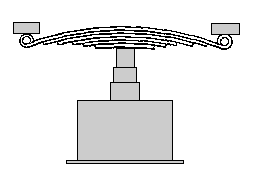
|
||||||||||||||||||||||||||||||
Bulldozing or Pre-setting a Leaf Spring |
||||||||||||||||||||||||||||||
|
Leaf Spring Types
Practically all leaf springs, as now used on cars, buses and trucks are of the semi-elliptic type. Because the semi-elliptic spring has the outstanding advantages of not only acting as a spring, to resiliently support the vehicle, but also serves the important functions of positioning the axles and of cushioning both driving torque and brake reaction, the simple semi-elliptic type has superseded many other kinds of springs, including cantilever; platform, full elliptic, etc. A semi-elliptic spring gives just as easy riding as the same amount of steel, built into a cantilever of full elliptic spring. |
||||||||||||||||||||||||||||||

Semi-Elliptic Spring |
||||||||||||||||||||||||||||||

|
||||||||||||||||||||||||||||||
Full Taper or ParabolicAlthough not new to the market, the full taper spring is now very popular for suspension systems on light to heavy truck application as well as some passenger car suspensions. The major advantages to this type spring are its superior ride and overall reduction of vehicle weight, which nets greater revenue per load miles. The full taper spring, although superior in some aspects, is not as forgiving as its counterpart the multi-leaf spring and should therefore be checked on regularly scheduled maintenance periods. KEEP U-BOLT NUTS TIGHT!"Tighten-and keep-those U-bolt nuts really tight" . . . is the keynote of good preventive maintenance of leaf springs. Operators of large fleets of trucks and buses have found that center breakage of springs is greatly reduced by "retightening" U-bolt nuts-after the first day's run-when a spring has been repaired or replaced. There are a number of surfaces between the leaves which bed down a little during the first day's operation. But retightening takes up the resulting slack and the spring then remains tight for a longer period. Just as it is good practice to retighten cylinder head nuts, after the engine has been run a few hundred miles. When installing U-bolts, it is good practice to use torque wrenches to determine when U-bolt nuts have been adequately tightened. Do not rely on impact wrenches to provide the needed torque to properly tighten the U-bolt. Impact wrenches can over or under torque the U-bolt, thus resulting in a failure to the U-bolt by over torquing or the spring by under torquing. But torque wrenches, like micrometer calipers, are only as good as the mechanic who uses them. Instances have occurred where, due to insufficient length of threads or badly cut threads, torque wrenches have merely measured the "pull around" of the nut on the U-bolt, rather than the "pull together" of the spring and axle pad. Not only should threads be a correct fit, but both threads and contacting surface of nut should be clean and free turning. |
||||||||||||||||||||||||||||||

|
||||||||||||||||||||||||||||||
Nuts may be tight while bolts are loose.When in doubt as to whether the U-bolt nuts are really clamping parts together tightly, a sharp "rap" with a hammer will sound the answer. Just as railroad car wheel inspectors rap car wheels, before each long trip. Further retightening, of new or repaired springs, is suggested at the end of the first 500 miles, after 1,000 miles and on appropriate intervals determined by individual preventive maintenance plans. Failure to retighten the U-bolts may lead to serious damage to the suspension system or serious injury or death to the vehicle operator. When a U-bolt has been torqued to its recommended torque level, the bolt and threads will stretch to mate with the deep nut. Because a properly installed U-bolt is stretched, it becomes apparent that the U-bolt should not be reused in repair. The stretching action on the threads will distort the threads enough to achieve a type of cross threading when the nut is removed. This action will tend to cut new threads as the nut is removed, thus lowering the U-bolt's ability to clamp by specified torque. |
||||||||||||||||||||||||||||||
|
||||||||||||||||||||||||||||||
|
Although the aforementioned methods of tightening are excellent rules of thumb, you must consider the U-bolt material being used. Basic bolt gradings are Grade 2, being the lowest, with Grade 5 thru Grade 8 obtaining higher and better strength. The chart below shows the Maximum Allowable Torque for Fine Thread Series on U-bolts. Consult the original equipment manual on recommended torques. Over torquing may damage other suspension parts. |
||||||||||||||||||||||||||||||
|
||||||||||||||||||||||||||||||
|
The TRI-8 cold drawn material lends itself very well to those spring shops which have installed U-bolt bending equipment capable of forming threaded rod into the formed U-bolt in the cold state. The ultimate tensile strength, yield strength, elongation and reduction in area meet the specifications for the mechanical properties of Grade 8 and the material has been accepted by several Original Equipment manufacturers for truck " trailer U-bolt application. We have emphasized U-bolt nut tightness because the center bolt area of a spring is the area of the least cross section in multi-leaf springs, hence the weakest area. If the U-bolts are loose, the center bolt area absorbs the greatest stress. When the center bolt area is clamped solidly against the axle pad, as in a vise, then the middle of the spring cannot bend and, if it cannot bend, then it also cannot break at this point. Because the middle of the spring is the place of greatest hazard, it is necessary to clamp it securely to prevent breakage at this point. It is possible for worn or improperly fitted axle pads to be a contributing cause of center spring breakage. Since many modern springs are flat, under normal full load, pads for such springs should also be flat, and only lightly rounded at the ends. U-BOLT TOP PLATE |
||||||||||||||||||||||||||||||
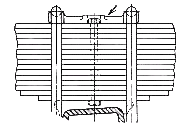
|
||||||||||||||||||||||||||||||
Don't Omit U-Bolt Top PlateWear of spring pads can only be caused by movement of the spring on the pads. If the U-bolts have been holding the spring so tightly to the pad that no movement occurs, there can be little wear. The U-bolt top plate is important for two reasons:
The top plate shape must mate with the shape of the U-bolt; do not use improperly shaped U-bolts or U-bolts produced on worn dies which may alter the intended top shape of the U-bolt. On square bend U-bolts, it is very important that the corner radius be at least 1/2 the diameter of the rod ie. 1" U-bolt legs will have a 1/2" radius at the bend. |
||||||||||||||||||||||||||||||
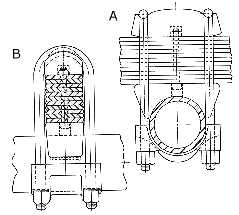
|
||||||||||||||||||||||||||||||
Typical center clamping of overslung spring |
||||||||||||||||||||||||||||||
|
|
||||||||||||||||||||||||||||||
Minimum U-Bolt Corner Radius |
||||||||||||||||||||||||||||||
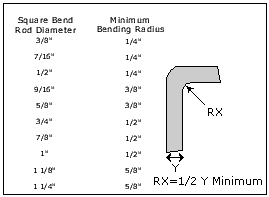
|
||||||||||||||||||||||||||||||
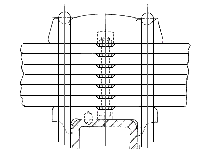
|
||||||||||||||||||||||||||||||
Center Bolt and Cupped Centers
The center bolt assists in assembling, shipping and handling of the spring before the spring is placed on the vehicle. After the spring is installed, the center bolt assists in preventing:
In all of these functions, it is only an assistant and, when a center bolt is bent or broken, the U-bolts should be suspected of having failed in their full duty of clamping the spring to the axle. Springs that are subjected to severe loads in the lengthwise motion are cupped to prevent this movement. Spring Eyes Spring eyes should have a free turning, but not a loose fit on the spring pins or shackle bolts. Except when rubber bushings are used in the spring eyes, as in some applications, the spring pin or shackle bolts should be regularly lubricated with chassis lubricant, to prevent freezing or binding of the spring eyes on the bolt. Improper lubrication might cause opening up of the eye, or "straight across" breakage of the main leaf near the eye.
Typical Eyes of Springs |
||||||||||||||||||||||||||||||
|
||||||||||||||||||||||||||||||
|
The military or full loose wrappers lengthwise clearance allows relative lengthwise freedom of the main and second leaves. But if the eye of the main leaf should break, the spring is retained in place by the wrapper eye of the second leaf, and the vehicle can still be safely transported to the nearest repair facility.
Heavy-Duty Spring Eyes. |
||||||||||||||||||||||||||||||
|
||||||||||||||||||||||||||||||
|
Add a leaf?
Adding a leaf, to increase the load carrying capacity of a spring seems so easy... we should think twice before doing so? Suspension systems are designed to carry specified loads; therefore all of its component parts are designed to carry specified parts of this load. In times of demanding economy, the truck and trailer manufacturer must endeavor to maintain or reduce the cost of vehicles. Therefore the suspension parts are designed with the minimum acceptable safety factor. Adding leaves to a spring may severely overload the suspension parts or vehicle itself. A properly designed spring is a balanced spring, with leaves so graded or "stepped" in length, with regard to the other leaves, that each leaf carries its fair share of the load. The lengths of the leaves of a spring, together with the thickness and individual leaf radii, determine the distribution of stresses along each leaf. Adding leaves without this in mind will upset the uniform stress distribution.Any alteration or change to the original design of a leaf spring may seriously damage the surrounding parts of the suspension system, thus placing the vehicle operator in jeopardy of serious injury or death by the suspension system failure. |
||||||||||||||||||||||||||||||
|
||||||||||||||||||||||||||||||
|
SPRING CLIPS
When a truck wheel hits a bump, the main leaf of the spring is strongly assisted by all the shorter leaves of the spring in resisting the shock. But, after the bump has been passed, the main leaf would ordinarily have to absorb most of the rebound-all by itself-if the main leaf was not assisted in absorbing the rebound by the other leaves, attached to the main leaf by means of rebound clips. |
||||||||||||||||||||||||||||||
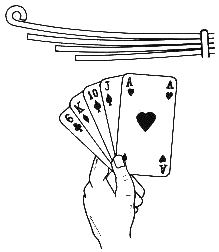
|
||||||||||||||||||||||||||||||
Spring clips prevent breakage due to fanning.The secondary function of the rebound clips is to prevent spreading or "fanning out" of the leaves, which might result in eventual breakage. For these two reasons, it is obviously important that broken rebound clips be replaced by "properly adjusted" rebound clips. |
||||||||||||||||||||||||||||||
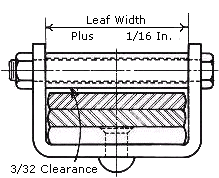
|
||||||||||||||||||||||||||||||
Proper Clip ClearancesWhile these rebound clips should control the leaves, they should not bind the ends of the leaves against lengthwise motion on each other. The width of the clip should be 1/16 inch or more over the nominal width of the spring. The spacer tube, over the spring clip bolt, maintains this width clearance. There should also be clearance between the spacer tube of the clip, and the main leaf of the spring to:
Clip bolts should be assembled with the head of the bolt away from the tire, so that if a nut should loosen and the clip bolt comes partly out, it will not cut the tire, and the nut end of the bolt should be peened over to prevent the nut from backing off. INSPECTIONBecause leaf spring suspensions usually give such trouble free performance, they are apt to be entirely neglected until trouble actually occurs. However, since springs and chassis parts are both working parts and structural parts, they will well repay the small amount of inspection and preventive maintenance service necessary to keep them in safest operating condition. Such spring suspension system inspection may be divided into:
Before a vehicle starts out, experienced mechanics can often spot a sagged spring by the low appearance of the front fenders. But a more reliable method is to check the clearance between the chassis frame and the shop floor. Of course the tire inflation must be considered, for greater accuracy. Or the distance between floor and wheel rim can be checked. Any tilting or unevenness of the vehicle body should alert the serviceman to the possibility of sagged springs. |
||||||||||||||||||||||||||||||

|
||||||||||||||||||||||||||||||
Distance from Fixed Hanger Bolt to Center bolt should be equal on both sides of vehicle.Now that we know the causes and cures for possible spring suspension troubles, let's make our spring check in this, or some other systematic manner, because, by following the same order each time, we are less apt to miss anything. Check leaves
Check radius rods " all other related parts of spring suspension. hangers, equalizers, beam bushings, etc. Check shock absorbers, as defective shock absorbers will definitely shorten spring life. It is important to remember that nearly all leaf spring fractures or cracks are of the progressive type-they start small. This gives the inspector a chance to locate small checks and cracks-before they become large fractures. Since spring steel is stronger in compression than in tension, most fractures start at the outer edge of the tension sides of the leaves. Building codes give a laminated wood beam a much higher safety rating than a beam of solid wood. The laminations (plates) of a leaf spring also give the leaf spring a higher safety rating-because it is very seldom that more than one leaf breaks at a time. The breakage of one leaf usually gives "warning" by
This gives ample time to replace it, before other leaves are damaged by the overload. However, let's not overwork this safety factor, but use reasonably careful driving to finish the day's run and then replace the broken leaf-before any other leaves are damaged by the "concentration" of stress over the edge of the broken leaf. However, if the main leaf is broken (unless the second leaf is of the wrapper" type, or there is a military wrap of the spring eye) it may be preferable to tow the vehicle to the spring service station. With either the military wrap of the second leaf around the eye of the main leaf, or the wrapper type of second leaf, the vehicle may usually proceed under its own power to the nearest repair facility, but this is not recommended. Moving a vehicle with a broken main leaf is extremely hazardous not only to the operator but to the component parts of the suspension due to abnormal movement of the axle. On the road. A tendency to "strike bottom" or hit the rubber bumpers may result from:
Springs of modern design are usually nearly flat-under normal full load conditions. When springs are nearly flat, they are in a better position to endure constant flexing, and they also tend to act as straight radius rods and so maintain axle positions and steering alignments more accurately. Consequently, when such modern springs have "reverse camber," the vehicle may be suspected of:
Springs of earlier designs often had more "arch" or camber and so may not have reverse camber, even when overloaded or sagged. Position and condition of shackles should be noted, to see if the angles of these shackles on the two sides of the vehicle are the same. The design of spring shackles is such to allow the spring free movement throughout its entire cycle from unloaded to "striking bottom." Proper design will also slow down the oscillation rate, or rate of bounce, and so gives a more comfortable ride. The shackle angle, for that particular vehicle, should be used as a guide. Wrong shackle angle may indicate a spring that is too long or too short for that vehicle. Also some present designs are in reverse camber under full load and are not overstressed in this position. Inspecting springs for quality and workmanship.1. Center hole. If made with good dies, it will be clean-cut. A poor center hole may set up additional stresses in the steel, which may cause premature breakage. 2. Trim points. Must be done with good equipment, to avoid cracking, chipping and rough edges. 3. Clips. Must be right size and shape to fit properly. 4. Eyes. Must be:
If the eye is too small, the bushing may be crushed when forced in. If the eye is too large, the bushing will be loose.
5. Fitting of leaves must be accurate, to avoid setting up excess stresses in steel and causing premature breakage. 6. Leaves must be fitted side to side, as well as surface to surface. DRIVING TIPS Engineers evaluate the factors determining the life of springs somewhat roughly in this manner. DesignWhen vehicles operate under special conditions, special design may considerably reduce spring costs per mile. Vehicle manufacturers produce for average conditions. Under special conditions, redesign may be necessary to insure improved performance. SteelSpring companies generally use steel of SAE specification 5160 or 51B60 which are developed for leaf spring use. ProcessingThe manufacture of springs includes the forming and the heat treating of the steel to temper and toughen it, and is equally as important as the steel itself. Improper heating and forming of heat treated steel will greatly reduce the strength of the steel by loss of proper heat treating and represents a serious safety hazard. MaintenanceLike such other vehicle parts as tires, engines, etc., the best made springs and chassis parts may be greatly handicapped by lack of proper maintenance. Vehicle DriverThe driver is the last but very important factor! To appreciate this, let's examine the action of the standard truck drive, which is widely used because of its important advantage in protecting other vehicle parts by providing resilient control of brake and torque applications. In this style drive, the leaf springs do three things:
|
||||||||||||||||||||||||||||||

|
||||||||||||||||||||||||||||||
|
Springs Cushion Brake and Acceleration Torque Reactions.
When the brakes are suddenly applied, the entire momentum of the moving vehicle tends to rotate the axle in a forward turning direction. At high speeds, the power of this momentum is terrific (As proven by collisions!) and the effect of this momentum on the axle is limited only by the skidding of the rubber tires on the road.This causes brake "wind-up of springs" which tends to bend springs in "S" form as shown in the sketch. Also, when starting a vehicle under adverse conditions of road, load or grade, the driver may race the engine and develop a lot of momentum in the fly-wheel. This torque is greatly multiplied by the transmission and this is again multiplied by the rear axle gears. So it is better (for all parts of the vehicle) not to race the engine and then let the clutch out with a "Bang!" Suppose the driver has been driving too fast and doesn't see a bump in the road until he is almost on top of it-what should he do? Of course he should have had the vehicle under better control. But in this predicament, he should apply the brake before reaching the bump, and then release brake in sufficient time to allow springs to regain normal position as the wheels (unchecked by brakes) roll freely over the bump. Otherwise it is possible for the brake reaction to have forced the spring into such a position that one-half of the spring was carrying the full weight of the vehicle, so the effect of the bump would be "twice" as great as when the wheels were allowed to run freely over it. |
||||||||||||||||||||||||||||||
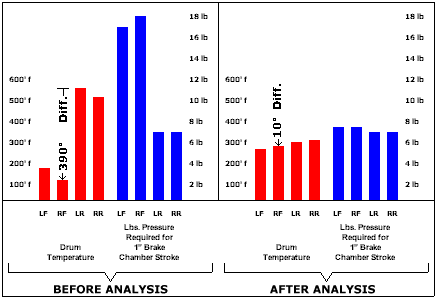
|
||||||||||||||||||||||||||||||
|
Unequalized Brakes are Unfair to Springs.
Like the inexpensive fuse which protects a more costly electric motor, the springs, which protect the more costly vehicle, should be regarded as "expendables"-to be replaced, when the limit of their "economic" life has been reached. Batteries, tires, and springs could be designed to last the entire life of the vehicle. But well designed springs, even though they require a minimum of care and occasional replacement, reduce vehicle costs per mile-which is the final yardstick by which satisfactory spring service is measured. |
||||||||||||||||||||||||||||||
|
||||||||||||||||||||||||||||||
|
Progressive Springs tend to equalize riding comfort under both light and heavy loads.
Springs of the progressive type not only give almost equal riding comfort for the lightly loaded and fully loaded vehicle, but they also have the additional advantage that there is less variation in spring deflection from light load to full load. Consequently the chassis frame remains more nearly level and better steering alignments and greater safety are obtained. Spring length is measured along curve of main leaf. Length of springs is measured along the main leaf, from center to center of the two eyes. That's the same distance as center-to-center distance, between the two eyes,when the main leaf is flat under normal full load. |
||||||||||||||||||||||||||||||
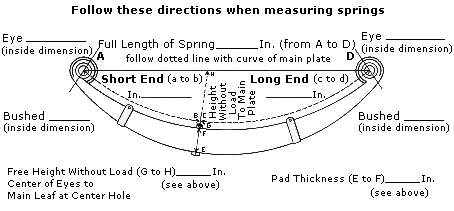
|
||||||||||||||||||||||||||||||
Bulletin Number 5M6/91 SP35740 Copyright © Triangle Spring Used with permission |
||||||||||||||||||||||||||||||